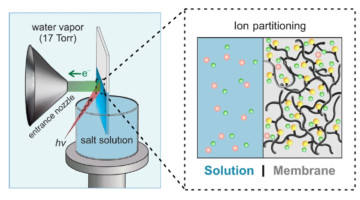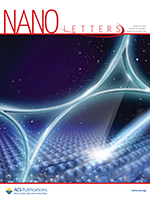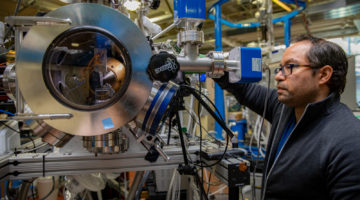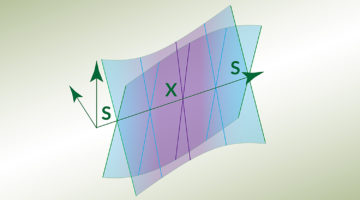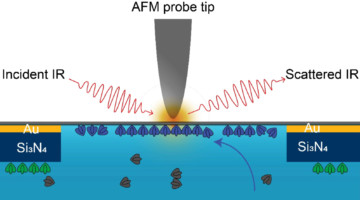Researchers performed the first direct measurement of the Donnan electrical potential, which arises from an imbalance of charges at membrane-solution interfaces. Considered unmeasurable for over a century, the Donnan potential is relevant to a wide range of fields, from cell biology to energy storage and water desalination. Read more »![]()
![]()
ALS Work Using Spectroscopy
These techniques are used to study the energies of particles that are emitted or absorbed by samples that are exposed to the light-source beam and are commonly used to determine the characteristics of chemical bonding and electron motion.
Dirac Nodal Line in Hourglass Semimetal Nb3SiTe6
Hourglass fermion in an electronic band structure is protected by the nonsymmorphic symmetry of a layered semimetal Nb3SiTe6. Angle-resolved photoemission spectroscopy demonstrates the band features of an hourglass fermion in k-space, such as band crossings and nodal loops. Read more »
The Donnan Potential, Revealed at Last
Researchers at the ALS recently led the first direct measurement of the Donnan potential, an electric potential that arises from an imbalance of charges at the interface of a charged membrane and a liquid. The work could yield new insights in areas such as ion transport through cellular membranes, ion exchange membranes in energy storage strategies, and water purification technologies. Read more »
Enhanced low-temperature proton conductivity in hydrogen-intercalated brownmillerite oxide
Solid oxide materials typically need high temperatures to allow appreciable ion transport, limiting their flexibility as electrolytes for energy devices. Lu et al. now show unusually high proton conductivity in a hydrogenated oxide between 40 °C and 140 °C, which they attribute to ordered vacancy channels and high proton concentrations. Read more »
Crossing from One to Two Dimensions in a Single Material
Low-dimensional materials exhibit excellent properties for use in next-generation electronic devices. Now, researchers have discovered an ideal platform for tuning between 1D and 2D physics, expanding the possibilities for device engineering and offering a versatile platform for the exploration of intriguing low-dimensional physics. Read more »
Watching Nanoparticle Chemistry and Structure Evolve
Using a multimodal approach, researchers learned how chemical properties correlate with structural changes during nanoparticle growth. The work will enable a greater understanding of the mechanisms affecting the durability of nanoparticles used to catalyze a broad range of chemical reactions, including clean-energy reactions. Read more »![]()
![]()
Liquid Heterostructures: Generation of Liquid–Liquid Interfaces in Free-Flowing Liquid Sheets
Microscope image of a microfluidic nozzle producing a liquid heterostructure: a layered flat liquid sheet with outer toluene layers and an inner water layer. The colored bands arise from thin film interference, indicating the presence of buried liquid‒liquid interfaces and submicron layer thicknesses. Read more »
A Nano-IR Probe for Proteins in Liquid Environments
A new technique using infrared (IR) light revealed how the self-assembly of proteins is affected by environmental conditions in a surrounding liquid. This nanoscale probe of soft matter in a liquid matrix will facilitate advances in biology, plastics processing, and energy-relevant applications such as electrocatalysts and batteries. Read more »![]()
![]()
Highly Selective Methane to Methanol Conversion on Inverse SnO2/Cu2O/Cu(111) Catalysts: Unique Properties of SnO2 Nanostructures and the Inhibition of the Direct Oxidative Combustion of Methane
Inverse catalysts generally consist of oxide nanoparticles supported on metal substrates, which can exhibit exceptional catalytic properties. The small SnO2 nanoparticles uniformly dispersed on a Cu2O/Cu(111) substrate enabled a unique SnO2–Cu2O interface that can completely convert methane to methanol directly under the environments of oxygen and water. Read more »
Multilayer Stack Opens Door to Low-Power Electronics
Researchers found that a multilayer stack of ultrathin materials exhibits a phenomenon called negative capacitance, which reduces the voltage required for transistor operation. The material is fully compatible with today’s silicon-based technology and is capable of reducing power consumption without sacrificing transistor size or performance. Read more »![]()
![]()
- « Previous Page
- 1
- …
- 6
- 7
- 8
- 9
- 10
- …
- 30
- Next Page »
